
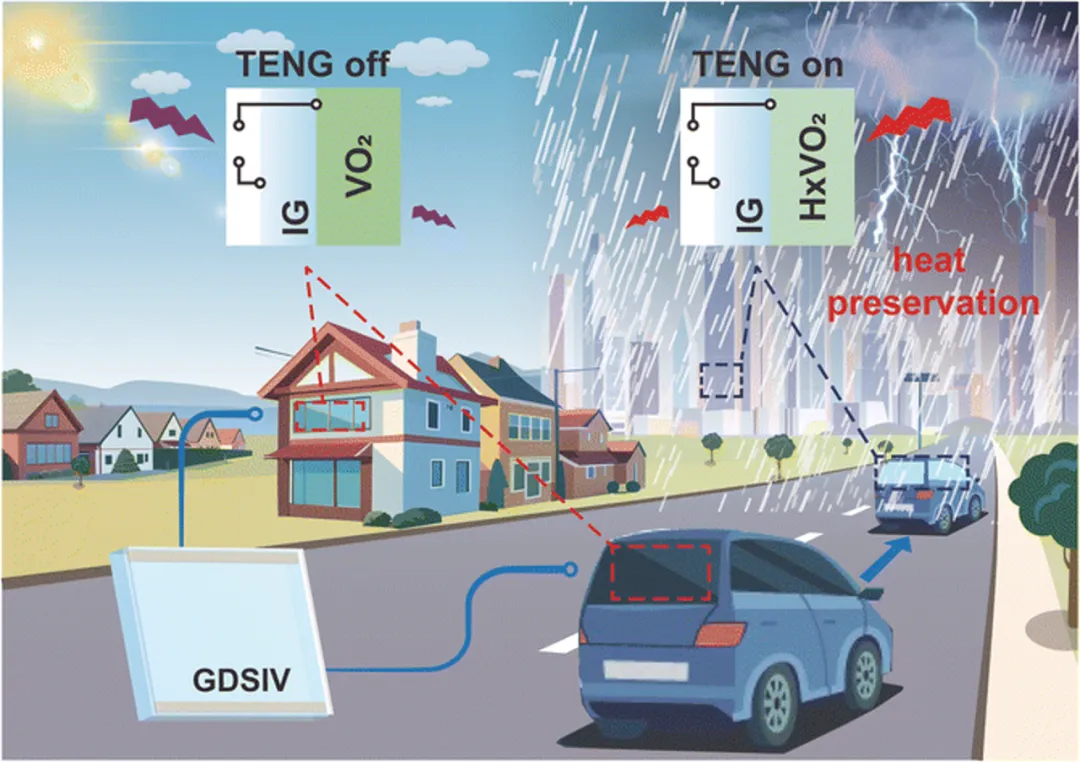
Research Background
The modulation of transition metal oxides (TMO) properties has significant application value in fields such as smart dimming, thermal insulation, and temperature sensing. Vanadium dioxide (VO₂) is a typical metal-insulator transition (MIT) material, which undergoes significant changes in its structural, electrical, and optical properties during the phase transition. Traditional phase transition modulation methods rely on external power sources or devices, leading to high usage costs and complex operations.
In recent years, triboelectric nanogenerators (TENG) that harvest environmental energy have proven to be an effective mechanical energy conversion technology, with unique advantages of low cost, simple structure, and environmental friendliness. Given the enormous potential of TENG as a sustainable power source, it is expected to achieve self-powered VO₂ phase transitions through the collection of environmental mechanical energy.
Article Introduction
Recently, a joint team led by Researcher Zhang Chi from the Beijing Institute of Nanoenergy and Nanosystems, and Associate Professor Chen Yuanfen from Guangxi University, reported a TENG-based self-powered VO₂ phase transition modulation technology that successfully realizes a reversible MIT triggered by mechanical energy. Environmental mechanical energy is converted into electrical energy by TENG, which is then rectified to serve as the gate voltage for the ionic gel (IG), thereby modulating the insertion or extraction of hydrogen ions from the VO₂ lattice at room temperature.
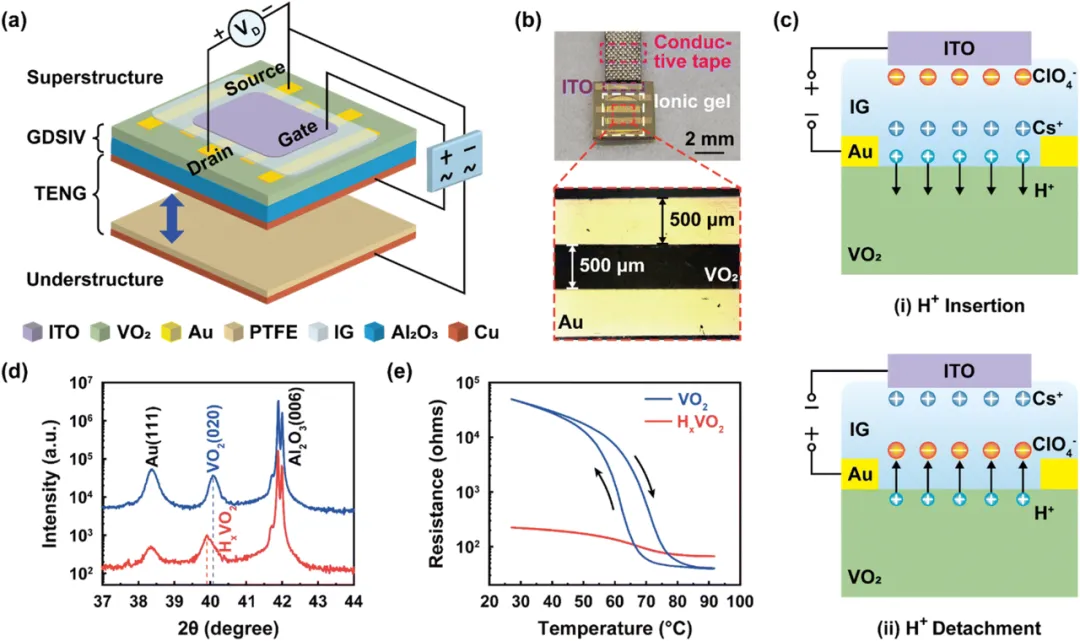
-
Fig 1. TENG-induced VO₂ thin film phase transition. (a) Schematic diagram of TENG-induced ionic gel (IG) gate-controlled phase transition. (b) Optical image of the GDSIV device. (c) Schematic diagram of the working principle of TENG-induced ionic gel gate-controlled phase transition: hydrogen ion insertion (ⅰ) and extraction (ⅱ). (d) X-ray diffraction scans of original VO₂ (blue) and HxVO₂ (red) on Al₂O3 substrate. (e) Resistance-temperature change curves of VO₂ and HxVO₂ thin films in air.
Various property changes of VO₂ under TENG-induced ionic gel gating were systematically studied. Structural characteristics were characterized by XRD and Raman spectroscopy. Under continuous power supply from TENG, the XRD peak of VO₂ shifted by 0.17° (Fig 1d), and the Raman characteristic peak of the M phase disappeared, confirming the feasibility of TENG-induced ionic gel gating to achieve VO₂ phase transition. Meanwhile, the phase transition modulated the transmittance and changed the color of VO₂ from brown to translucent.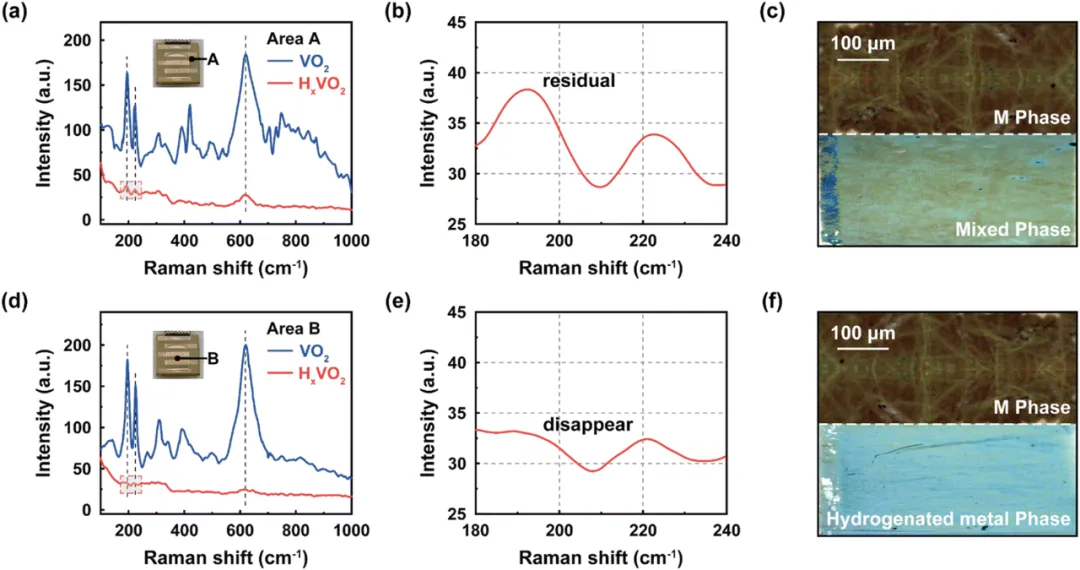
-
Fig 2. Insulator-metal phase transition process. (a) Comparison of Raman spectra before and after hydrogenation in area A at room temperature. (b) Enlarged Raman spectrum of residual VO₂ characteristic peaks. (c) Optical microscope images of M phase and mixed phase. (d) Comparison of Raman spectra before and after hydrogenation in area B at room temperature. (e) Enlarged Raman spectrum of VO₂ characteristic peaks after complete hydrogenation. (f) Optical microscope images of M phase and hydrogenated metallic phase.
The electrical properties of VO₂ also changed significantly, with conductivity increasing by two orders of magnitude, and this process is reversible. This phase transition can last throughout the night. Additionally, the VO₂ phase transition induced by raindrop TENG was demonstrated. Due to the phase transition, the infrared transmittance of VO₂ was significantly reduced by 28.1%, achieving thermal insulation, which is expected to enable adaptive thermal insulation of smart windows through power generation from raindrops during rainfall.
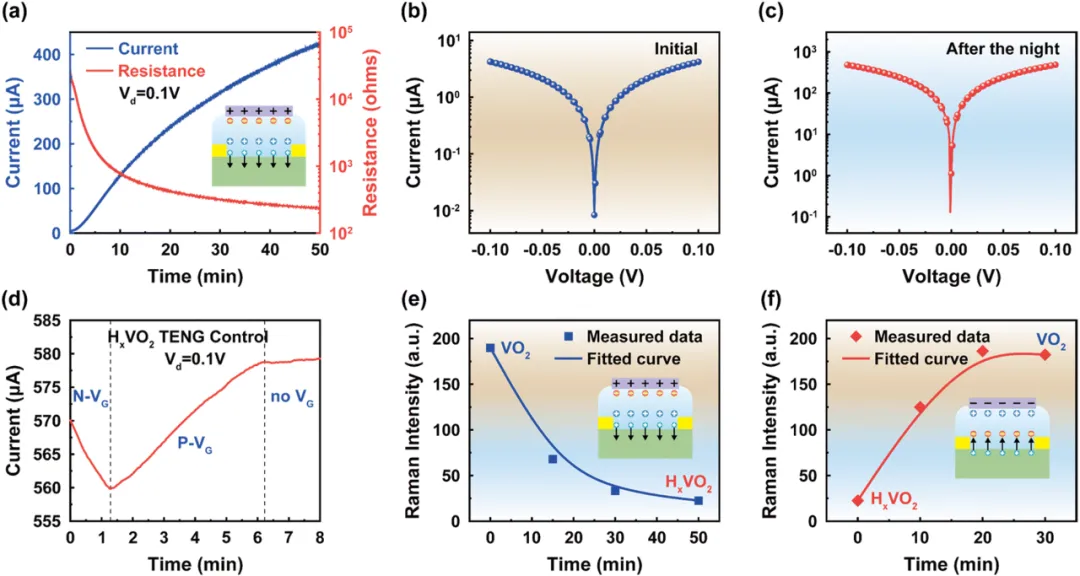
- Fig 3. Reversibility test of TENG-induced phase transition. (a) Output characteristics of drain current (ID) and resistance curve over time with drain voltage (VD) at 0.1 V during TENG operation. (b) I-V curve of the GDSIV device at the initial state. (c) I-V curve of the GDSIV device after overnight operation. (d) Relationship between ID and TENG operation time (negative VG, positive VG, and no VG applied). (e) Relationship between TENG operation time and Raman intensity of VO₂ characteristic peaks under positive (f) and negative gate voltages.
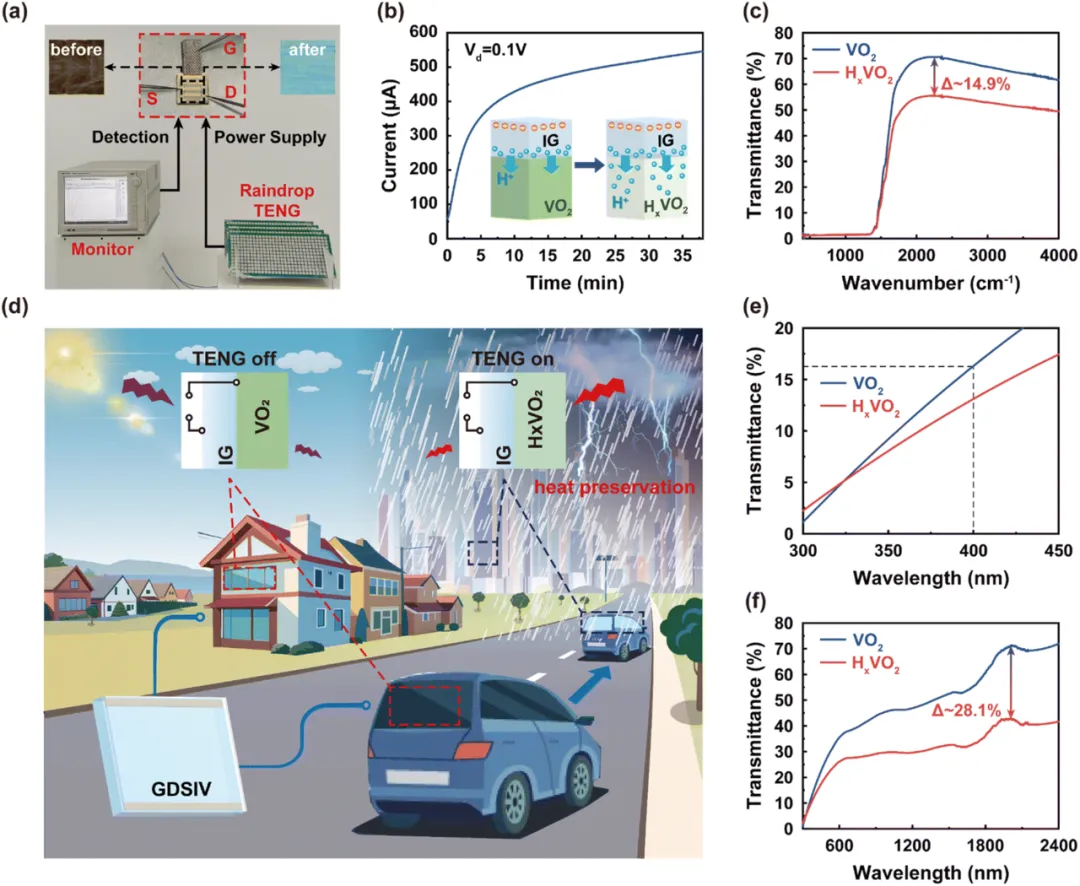
-
Fig 4. Application of self-powered VO2 phase transition in smart windows. (a) Demonstration of raindrop TENG-driven VO₂ phase transition in an experimental environment. (b) Changes in conductivity during the VO₂ phase transition. (c) Fourier transform infrared spectra of VO₂ and HxVO₂ thin films. (d) Schematic diagram of adaptive color-changing thermal insulation window. (e) Transmittance of VO₂ and HxVO₂ thin films in the ultraviolet range. (f) Ultraviolet-visible-near-infrared spectra of VO₂ and HxVO₂ thin films.
This work successfully achieved a TENG-based self-powered VO₂ phase transition, which has enormous application potential in smart homes and other fields. The results were published in the journal of the Royal Society of Chemistry, Journal of Materials Chemistry A, under the title “Self-powered VO₂ phase transition based on triboelectric nanogenerator“, and selected as hot papers. Guangxi University master’s student Dang Tianrui is the first author of this paper, while Dr. Zhao Junqing from the Beijing Institute of Nanoenergy is a co-first author, and Associate Professor Chen Yuanfen and Researcher Zhang Chi are co-corresponding authors.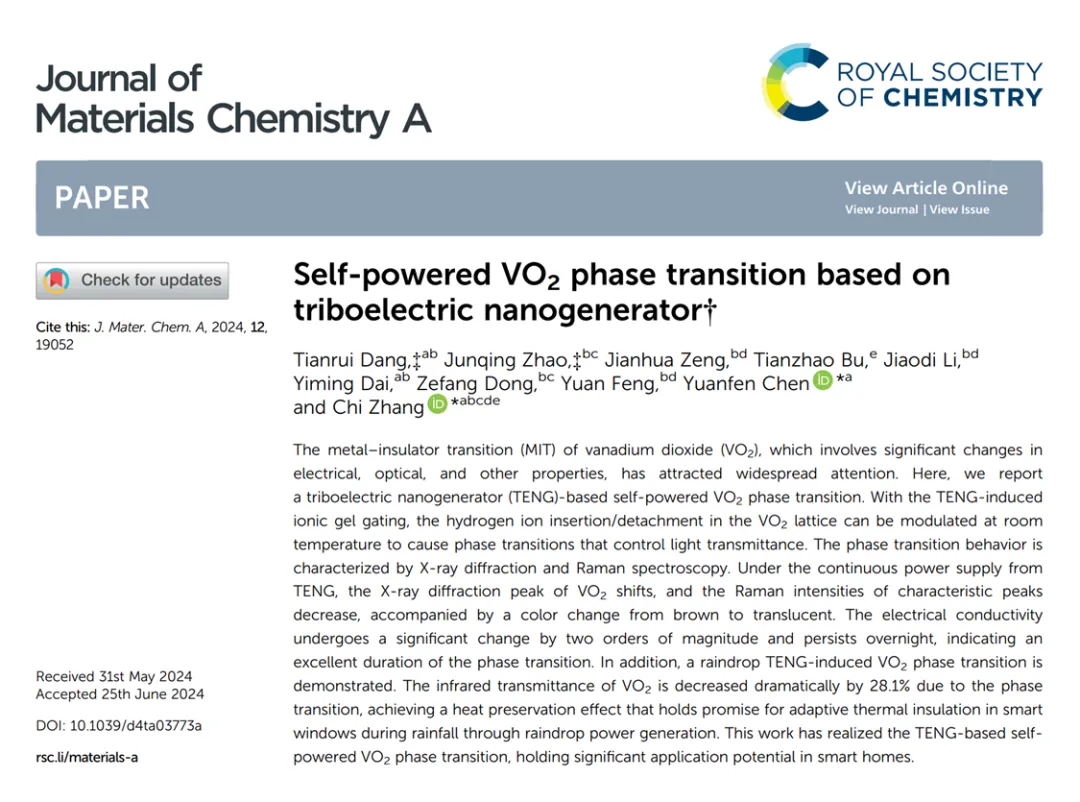
Paper Information
-
Self-powered VO2 phase transition based on triboelectric nanogenerator
Tianrui Dang,‡ Junqing Zhao,‡ Jianhua Zeng, Tianzhao Bu, Jiaodi Li, Yiming Dai, Zefang Dong, Yuan Feng, Yuanfen Chen* and Chi Zhang*
J. Mater. Chem. A, 2024, 12, 19052-19059 https://doi.org/10.1039/D4TA03773A
Source: RSC
For submissions, reprints, and collaborations, please contact WeChat:MatResFron001
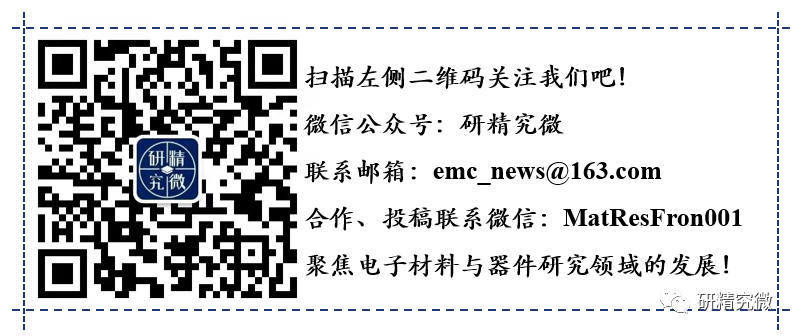
Welcome to leave comments and share your views.Support the authors by clicking the “like” button in the bottom right corner” and “viewing”↓↓↓